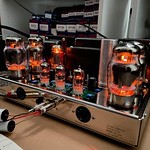deepee99 wrote:Peter,
Well, how ya know how your speaks gonna sound if you haven't something besides an iPad to drive them with.

?
Seriously, speaks are every bit as important as the amp/pre-amp configuration. Jes' making sure you were awake.
OTOH, a $40 driver tube might make as big an improvement as a $40 million speaker upgrade.
While you're awake, you started or contributed to thread ref: slow-blow fuses and the advantages of a certain type. Just looking for a description and model range.
Tnx
dave
On the fuses, look for MDQ/MDL-series 3AG size. These are true dual-element fuses that behave as standard-blow fuses during normal operation, but can handle 3x - 5x surges at turn-on. Not cheap at fractional amperages, but reasonable from about 2A up. Also standard issue for "back-in-the-day" Dynaco. MDL can be spiral slow-blow or dual-element. Stick with the dual element.
As to speakers, keeping it really basic: I know what I like in speakers, I know the environs in which they are expected to live. Therefore it is incumbent on me to provide them what they need to do so. And, I am perhaps irrationally a huge advocate of the concept of Headroom. At this moment, I run:
Maggies - power-pigs requiring my biggest brute-force amp (Citation 16) in a large room.
AR3a - part of a classic pairing, the AR receiver and speakers. In a much smaller room. My ST70 would likely be OK with them, but tubes are not as 'wife-friendly' as a one-knob solution (the AR receiver).
AR M5 - driven by my all HK Citation system. Very good against the Citation 19 at 100 wpc.
AR Athena - a very nearly perfect match to the ST70.
AR 14 - a very nearly perfect match to the Scott LK150. Two-way speakers that remind me a great deal of the 'large Advents', only with better drivers.
AR4x - a very nearly perfect match to either the ST35 (in a small room) or the AR amp/tuner combo (in a slightly large room). I have owned *these* speakers for more than 40 years. They were my very first speakers back in those distant days.
I have rejected speakers by Boston Acoustics, Allison, Klipsch, Advent, KLH, Accustat, ADS, McIntosh, Fisher and many others over the years. One of the kids has a pair of Dynaco, another Revox. So, amongst the non-exotic, consumer-grade speakers, I have tried more than a few.
But, the bottom line is that the speakers drive the electronics, the electronics do not limit the speakers. Ah, well. And Baskin-Robbins has many flavors of Ice Cream!
OT Comment: I just realized the other day how absolutely lucky I am with this hobby and my habits. Not only does my wife permit me to put the AR3a and Maggie speakers where they should be in two key rooms in the house, but for my birthday, I found a soldering re-work station, and a set of 'helping hands'
https://www.amazon.com/QuadHands-Helping-Hands-Third-Soldering/dp/B00GIKVP5K wrapped up for me. Neither prompted or requested. She, apparently, got in touch with a neighbor-friend for whom I have repaired some tube stuff - and asked what I might need. OK the soldering station is from China, but it adds capacity that I do not have, including hot air and desoldering functions. I will not complain. BUT, she does know my fixation on hand-tools. The helping hands are made in USA, and very, very nice.




 peterh
peterh